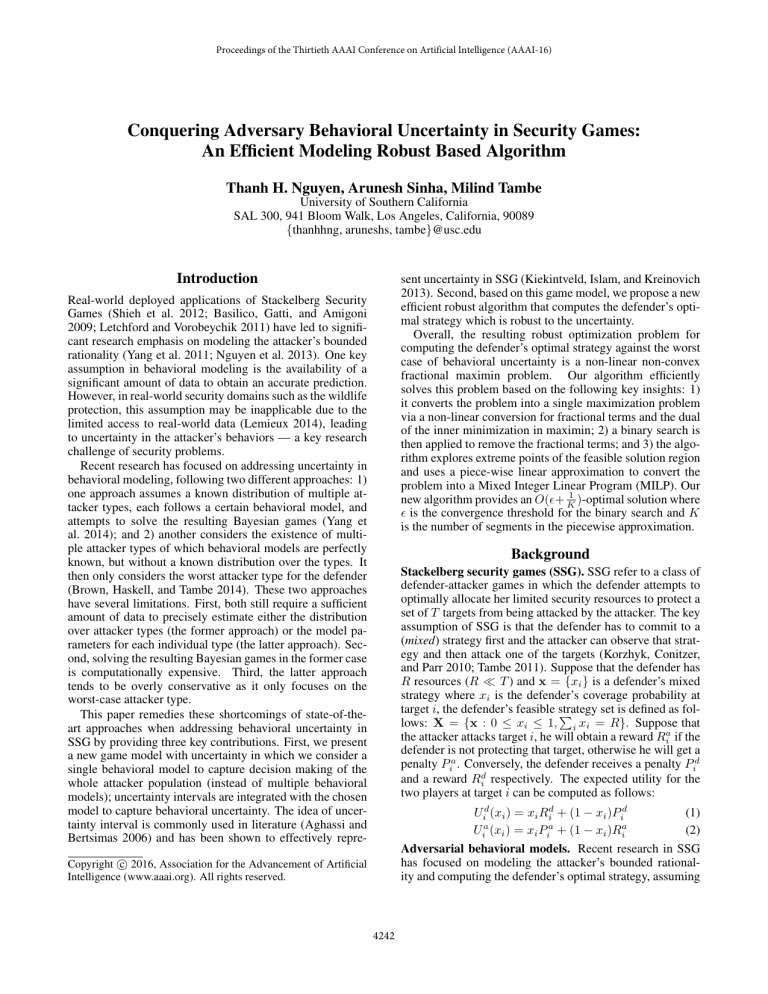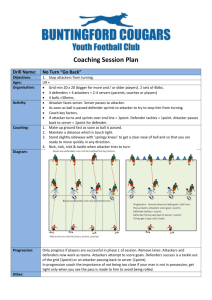
Proceedings of the Thirtieth AAAI Conference on Artificial Intelligence (AAAI-16)
Conquering Adversary Behavioral Uncertainty in Security Games:
An Efficient Modeling Robust Based Algorithm
Thanh H. Nguyen, Arunesh Sinha, Milind Tambe
University of Southern California
SAL 300, 941 Bloom Walk, Los Angeles, California, 90089
{thanhhng, aruneshs, tambe}@usc.edu
Introduction
sent uncertainty in SSG (Kiekintveld, Islam, and Kreinovich
2013). Second, based on this game model, we propose a new
efficient robust algorithm that computes the defender’s optimal strategy which is robust to the uncertainty.
Overall, the resulting robust optimization problem for
computing the defender’s optimal strategy against the worst
case of behavioral uncertainty is a non-linear non-convex
fractional maximin problem. Our algorithm efficiently
solves this problem based on the following key insights: 1)
it converts the problem into a single maximization problem
via a non-linear conversion for fractional terms and the dual
of the inner minimization in maximin; 2) a binary search is
then applied to remove the fractional terms; and 3) the algorithm explores extreme points of the feasible solution region
and uses a piece-wise linear approximation to convert the
problem into a Mixed Integer Linear Program (MILP). Our
1
)-optimal solution where
new algorithm provides an O(+ K
is the convergence threshold for the binary search and K
is the number of segments in the piecewise approximation.
Real-world deployed applications of Stackelberg Security
Games (Shieh et al. 2012; Basilico, Gatti, and Amigoni
2009; Letchford and Vorobeychik 2011) have led to significant research emphasis on modeling the attacker’s bounded
rationality (Yang et al. 2011; Nguyen et al. 2013). One key
assumption in behavioral modeling is the availability of a
significant amount of data to obtain an accurate prediction.
However, in real-world security domains such as the wildlife
protection, this assumption may be inapplicable due to the
limited access to real-world data (Lemieux 2014), leading
to uncertainty in the attacker’s behaviors — a key research
challenge of security problems.
Recent research has focused on addressing uncertainty in
behavioral modeling, following two different approaches: 1)
one approach assumes a known distribution of multiple attacker types, each follows a certain behavioral model, and
attempts to solve the resulting Bayesian games (Yang et
al. 2014); and 2) another considers the existence of multiple attacker types of which behavioral models are perfectly
known, but without a known distribution over the types. It
then only considers the worst attacker type for the defender
(Brown, Haskell, and Tambe 2014). These two approaches
have several limitations. First, both still require a sufficient
amount of data to precisely estimate either the distribution
over attacker types (the former approach) or the model parameters for each individual type (the latter approach). Second, solving the resulting Bayesian games in the former case
is computationally expensive. Third, the latter approach
tends to be overly conservative as it only focuses on the
worst-case attacker type.
This paper remedies these shortcomings of state-of-theart approaches when addressing behavioral uncertainty in
SSG by providing three key contributions. First, we present
a new game model with uncertainty in which we consider a
single behavioral model to capture decision making of the
whole attacker population (instead of multiple behavioral
models); uncertainty intervals are integrated with the chosen
model to capture behavioral uncertainty. The idea of uncertainty interval is commonly used in literature (Aghassi and
Bertsimas 2006) and has been shown to effectively repre-
Background
Stackelberg security games (SSG). SSG refer to a class of
defender-attacker games in which the defender attempts to
optimally allocate her limited security resources to protect a
set of T targets from being attacked by the attacker. The key
assumption of SSG is that the defender has to commit to a
(mixed) strategy first and the attacker can observe that strategy and then attack one of the targets (Korzhyk, Conitzer,
and Parr 2010; Tambe 2011). Suppose that the defender has
R resources (R T ) and x = {xi } is a defender’s mixed
strategy where xi is the defender’s coverage probability at
target i, the defender’s feasible strategy
set is defined as fol
lows: X = {x : 0 ≤ xi ≤ 1, i xi = R}. Suppose that
the attacker attacks target i, he will obtain a reward Ria if the
defender is not protecting that target, otherwise he will get a
penalty Pia . Conversely, the defender receives a penalty Pid
and a reward Rid respectively. The expected utility for the
two players at target i can be computed as follows:
Uid (xi ) = xi Rid + (1 − xi )Pid
(1)
a
a
a
(2)
Ui (xi ) = xi Pi + (1 − xi )Ri
Adversarial behavioral models. Recent research in SSG
has focused on modeling the attacker’s bounded rationality and computing the defender’s optimal strategy, assuming
c 2016, Association for the Advancement of Artificial
Copyright Intelligence (www.aaai.org). All rights reserved.
4242
the attacker’s response follows the given behavioral model.
One leading class of behavioral models is Quantal Response
(QR) (McFadden 1972; McKelvey and Palfrey 1995). In
modeling the attacker’s decision making, we consider a general discrete choice model of QR to capture behaviors of the
attacker (Train 2009) in which the probability that the attacker chooses target i, qi (x), is predicted as follows:
Fi (xi )
qi (xi ) = j Fj (xj )
duality which is a linear maximization problem. Therefore,
we can merge this dual with the outer maximization of (4)
to obtain a single maximization problem.
Given the resulting new maximization problem, we then
apply a binary search to remove fractional terms. We explore extreme points of the feasible solution region and use
piece-wise linear approximation to convert the resulting feasibility problem at each binary
step
into a MILP. Our new
1
-optimal solution of the
algorithm provides an O + K
maximin problem (4).
Acknowledgements: This research was supported by
MURI Grant W911NF-11-1-0332 and by CREATE under
grant number 2010-ST-061-RE0001.
(3)
where Fi (xi ) : [0, 1] → R∗ is a positive and monotonically
decreasing function of xi at target i.
Uncertainty in Behavioral Modeling
References
Due to the behavioral uncertainty, we assume that the value
of Fi (xi ) in (3) is not perfectly known given xi . Instead, Fi (xi ) has known lower and upper bounds, Li (xi ) ≤
Fi (xi ) ≤ Ui (xi ) where Li (xi ), Ui (xi ) : [0, 1] → R∗ are
positive functions of the defender coverage at target i. Denote by I(xi ) = [Li (xi ), Ui (xi )] the uncertainty interval,
the interval size indicates the uncertainty level when modeling, which could be specified based on the available data for
learning. We aim at computing the defender’s optimal strategy by maximizing her utility under the worst case resulting
from the behavioral uncertainty. The corresponding robust
optimization problem is represented as follows:
max
min
qi (xi )Uid (xi )
(4)
Aghassi, M., and Bertsimas, D. 2006. Robust game theory.
Mathematical Programming 107(1-2):231–273.
Basilico, N.; Gatti, N.; and Amigoni, F. 2009. Leaderfollower strategies for robotic patrolling in environments with
arbitrary topologies. In AAMAS, 57–64.
Brown, M.; Haskell, W. B.; and Tambe, M. 2014. Addressing scalability and robustness in security games with multiple
boundedly rational adversaries. In GameSec.
Kiekintveld, C.; Islam, T.; and Kreinovich, V. 2013. Security
games with interval uncertainty. In AAMAS.
Korzhyk, D.; Conitzer, V.; and Parr, R. 2010. Complexity of
computing optimal stackelberg strategies in security resource
allocation games. In AAAI.
Lemieux, A. M. 2014. Situational Prevention of Poaching.
Routledge.
Letchford, J., and Vorobeychik, Y. 2011. Computing randomized security strategies in networked domains. In Applied
Adversarial Reasoning and Risk Modeling.
McFadden, D. 1972. Conditional logit analysis of qualitative
choice behavior. Technical report.
McKelvey, R., and Palfrey, T. 1995. Quantal response equilibria for normal form games. Games and economic behavior
10(1):6–38.
Nguyen, T. H.; Yang, R.; Azaria, A.; Kraus, S.; and Tambe,
M. 2013. Analyzing the effectiveness of adversary modeling
in security games. In AAAI.
Shieh, E.; An, B.; Yang, R.; Tambe, M.; Baldwin, C.; DiRenzo, J.; Maule, B.; and Meyer, G. 2012. Protect: A deployed game theoretic system to protect the ports of the united
states. In AAMAS.
Tambe, M. 2011. Security and Game Theory: Algorithms,
Deployed Systems, Lessons Learned. Cambridge University
Press.
Train, K. E. 2009. Discrete choice methods with simulation.
Cambridge university press.
Yang, R.; Kiekintveld, C.; Ordonez, F.; Tambe, M.; and John,
R. 2011. Improving resource allocation strategy against human adversaries in security games. In IJCAI.
Yang, R.; Ford, B.; Tambe, M.; and Lemieux, A. 2014. Adaptive resource allocation for wildlife protection against illegal
poachers. In AAMAS.
x∈X Fi (xi )∈I(xi ),∀i
i
Overall, the problem (4) is non-convex which is difficult
to solve. We present our novel algorithm which efficiently
solves the maximin problem (4) with a bound guarantee on
its approximate solution. In short, there are three key ideas.
First, we convert (4) into a single maximization problem via
a non-linear conversion for fractional terms and dualty of the
inner minimization in (4). Given a defender strategy x, the
objective of (4) remains a non-linear fractional function of
Fi (xi ), thus making the inner minimization problem in (4)
non-linear and fractional. We introduce the following new
i)
variables: yi = qi (xi ) = FiF(xj (x
which is the attacking
j)
j
probability at target i and z = F1j (xj ) which is the norj
malization term in the attacking probabilities. By replacing
Fi (xi ) with the new variables and denote by y = {yi }, we
can represent the inner minimization of (4) as the following
linear minimization problem of the new variables y and z:
yi Uid (xi )
(5)
miny,z
i
s.t.
yi = 1
(6)
i
Li (xi )z ≤ yi ≤ Ui (xi )z, ∀i.
(7)
where constraint (6) ensures
the condition on the attacking
probability distribution that i qi (xi ) = 1 holds. In addition, constraint (7) is equivalent to the condition on the lower
and upper bound of Fi (xi ) that Fi (xi ) ∈ [Li (xi ), Ui (xi )].
As (5 – 7) is a linear minimization problem of y and z, its
optimal solution is equivalent to the optimal solution of its
4243







